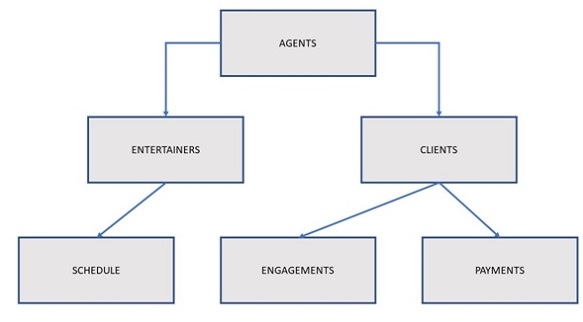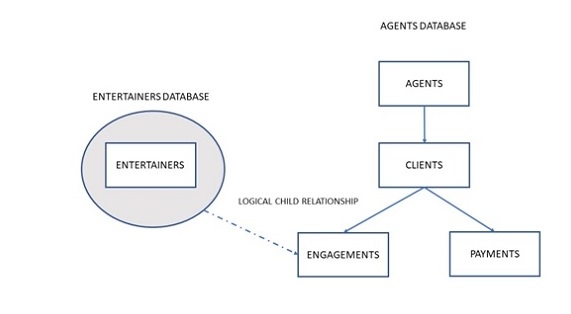
 Data Structure
Data Structure Networking
Networking RDBMS
RDBMS Operating System
Operating System Java
Java MS Excel
MS Excel iOS
iOS HTML
HTML CSS
CSS Android
Android Python
Python C Programming
C Programming C++
C++ C#
C# MongoDB
MongoDB MySQL
MySQL Javascript
Javascript PHP
PHP
- Selected Reading
- UPSC IAS Exams Notes
- Developer's Best Practices
- Questions and Answers
- Effective Resume Writing
- HR Interview Questions
- Computer Glossary
- Who is Who
Hierarchical Database Model
A hierarchical model represents the data in a tree-like structure in which there is a single parent for each record. To maintain order there is a sort field which keeps sibling nodes into a recorded manner. These types of models are designed basically for the early mainframe database management systems, like the Information Management System (IMS) by IBM.
This model structure allows the one-to-one and a one-to-many relationship between two/ various types of data. This structure is very helpful in describing many relationships in the real world; table of contents, any nested and sorted information.
The hierarchical structure is used as the physical order of records in storage. One can access the records by navigating down through the data structure using pointers which are combined with sequential accessing. Therefore, the hierarchical structure is not suitable for certain database operations when a full path is not also included for each record.
Data in this type of database is structured hierarchically and is typically developed as an inverted tree. The "root" in the structure is a single table in the database and other tables act as the branches flowing from the root. The diagram below shows a typical hierarchical database structure.

Agents Database
In the above diagram, an agent books several entertainers, and each entertainer, in return has his/her own schedule. It is the duty of an agent to maintain several clients whose entertainment needs are to be met. A client books engagement through the agent and makes payments to the agent for his services.
A relationship in this database model is represented by the term parent/child. A parent table can be linked with one or more child tables in this type of relationship, but a single child table can be linked with only one parent table. The tables are explicitly linked via a pointer/index or by the physical arrangement of the records within the tables.
A user can access the data by starting at the root table and working down through the tree to the target data. the user must be familiar with the structure of the database to access the data without any complexity.
Advantages
- A user can retrieve data very quickly due to the presence of explicit links between the table structures.
- The referential integrity is built in and automatically enforced due to which a record in a child table must be linked to an existing record in a parent table, along with that if a record deleted in the parent table then that will cause all associated records in the child table to be deleted as well.
Disadvantages
- When a user needs to store a record in a child table that is currently unrelated to any record in a parent table, it gets difficulty in recording and user must record an additional entry in the parent table.
- This type of database cannot support complex relationships, and there is also a problem of redundancy, which can result in producing inaccurate information due to the inconsistent recording of data at various sites.
Consider an example using the database diagram shown in the previous diagram. A user cannot enter a new record for the entertainer in the Entertainers table until the entertainer is assigned to a specific agent in the Agents table since a record in a child table (Entertainers) must be related to a record in the parent table (Agents). Therefore, this type of database suffers from the problem of redundant data. For example, if there is a many-to-many relationship between clients and entertainers; an entertainer will perform for many clients, and a client will hire many entertainers. This type of relationship in a hierarchical database cannot easily model, so developers must introduce redundant data into both the Schedule and Engagements tables.
- The Schedule table will now have client data which contains information such as client name, address, and phone number to show for whom and where each entertainer is performing. This data is redundant because it is currently stored also in the Clients table.
- The Engagements table will now contain data on entertainers which contains information such as entertainer name, phone number, and type of entertainer to indicate which entertainers are performing for a given client. This data is also redundant because it is currently stored in the Entertainers table.
The problem with this redundancy is that it can result in producing inaccurate information because it opens the possibility of allowing a user to enter a single piece of data inconsistently.
This problem can be solved by creating one hierarchical database specifically for entertainers and another one specifically for agents. The Entertainers database will contain only the data recorded in the Entertainers table, and the revised Agents database will contain the data recorded in Agents, Clients, Payments, and Engagements tables. there is no need of as you can define a logical child relationship between the Engagements table in the Agents database and the Entertainers table in the Entertainers database. With this relationship in place, you can retrieve a variety of information, such as a list of booked entertainers for a given client or a performance schedule for a given entertainer. The below diagram describes the whole picture.

The hierarchical database suited well to the tape storage systems which is used by mainframes in the 1970s and was very popular in organizations whose database is based on those systems. But, even though the hierarchical database provided fast and direct access to data and was useful in several circumstances, it was clear that a new database model was needed to address the growing problems of data redundancy and complex relationships among data.
The idea behind this database model is useful for a certain type of data storage, but it is not extremely versatile and is confined to some specific uses.
For example, where each individual person in a company may report to a given department, the department can be used as a parent record and the individual employees will represent secondary records, each of which links back to that one parent record in a hierarchical structure.

